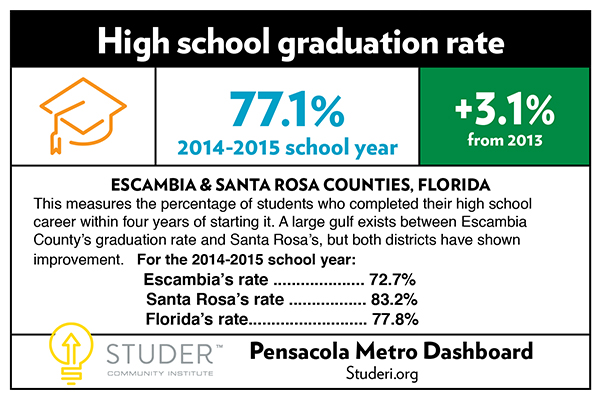The economics of a high school diploma
- January 12, 2016
- / Reggie Dogan
- / education

The quality of public education is one of the benchmarks business owners look at when contemplating whether to relocate or start a new company.
There is little doubt that Escambia County schools Superintendent Malcolm Thomas is reminded of that on a regular basis.
So, good news about high school graduation rates can't be trumpeted enough.
The district’s overall graduation rate increase of 6.6 percentage points to 72.7 percent is worthy of celebration.
Since 2011, Escambia’s graduation rate has gradually increased 15 percentage points, reaching it highest level since the state started keeping track of the statistics.
The high school graduation rate is one of 16 benchmark metrics that the Studer Community Institute measures in the Pensacola Metro Dashboard. Developed with the University of West Florida, the dashboard is a snapshot of the educational, economic and social well-being of the community.
While the superintendent of schools is proud of the schools’ success, Thomas said the district has been working hard for a while to improve graduation rates, but it takes time for the results to show.
“When you make an adjustment for graduation rates, you won’t see the fruit of that for three or four years,” Thomas said. “What we celebrate did not happen in 2015. That started to happen in 2009 and 2010."
Thomas said the district has put in place a system of checks and balances to improve academic achievement over time and push students toward the ultimate goal of high school graduation.
But it takes more than a systematic plan to make it work, Thomas said.
“It’s about the family and the students buying into this idea that being a high school graduate is important,” he said. “When you start in ninth grade you should expect to graduate in four years.”
Escambia’s new milestone is part of a national trend that has seen graduation rates ticking upward in recent years.
The U.S. Department of Education says the nation’s high school graduation rate reached 82 percent for the Class of 2014, an all-time high.
Statewide, Florida’s graduation rate reached a 12-year high, climbing to 77.8 percent, an increase of more than 18 percentage points since 2003-2004, and up 1.7 percentage points over last year.
There are many reasons to celebrate the increase in graduation and the benefits it brings to a community.
High school graduates earn, on average, at least 38 percent more money per week than do high school dropouts — and, with even more education, income rises substantially.
High school graduates also live healthier, longer lives on average, and are less likely to go to jail or live in poverty.
Unemployment among high school dropouts nationwide last year was 51 percent higher than among high school graduates, according to the Bureau of Labor Statistics.
Low graduation rates and high dropout rates have other economic and social costs.
According to the National Dropout Prevention Center, high school dropouts cost us all collectively hundreds of billions of dollars in lost earnings and tax revenue. Nationwide, 75 percent of prison inmates are dropouts. To put that in perspective, 52 percent of African Americans who do not graduate from high school currently end up in jail by their early 30s.
Dropouts are also more likely to be illiterate, single parents and dependent on welfare. Their mortality rate is 36 percent higher than that of high school graduates and 215 percent higher than people who have at least some higher education.
While Thomas is ecstatic about the big jump in the graduation rate, he understands that the work is far from over.
Thomas said that every school must work toward the goal of ensuring that each of their students earns a high school diploma.
Unlike the bygone years when people could drop out of school and find good-paying jobs in factories and plants, today’s job market demands a skill, specified job training and/or higher education.
Without a high school diploma in 2015, young people just won’t make it today, Thomas said.
“It is the ticket to get you started on the rest of your life,” he said. “Without that ticket you will not compete very well. It will shut so many doors and opportunities for the rest of that student’s life.”

 CivicCon launches with a look at good growth in cities
CivicCon launches with a look at good growth in cities
 Building stronger brains one baby, one parent at a time
Building stronger brains one baby, one parent at a time
 SCI debuts commercial on Early Learning City
SCI debuts commercial on Early Learning City
 Entrecon: World class speakers and an opportunity to sharpen skills
Entrecon: World class speakers and an opportunity to sharpen skills
 PYP Quality of Life survey 2017
PYP Quality of Life survey 2017
 EntreCon Pensacola 2016: A look back
EntreCon Pensacola 2016: A look back
 Leadership tip: getting better employee takeaways
Leadership tip: getting better employee takeaways
 Leadership tip: be interested instead of interesting
Leadership tip: be interested instead of interesting
 Leadership tip: delivering difficult messages
Leadership tip: delivering difficult messages
 Brain Bags boost Arc, Early Childhood Court programs
Brain Bags boost Arc, Early Childhood Court programs